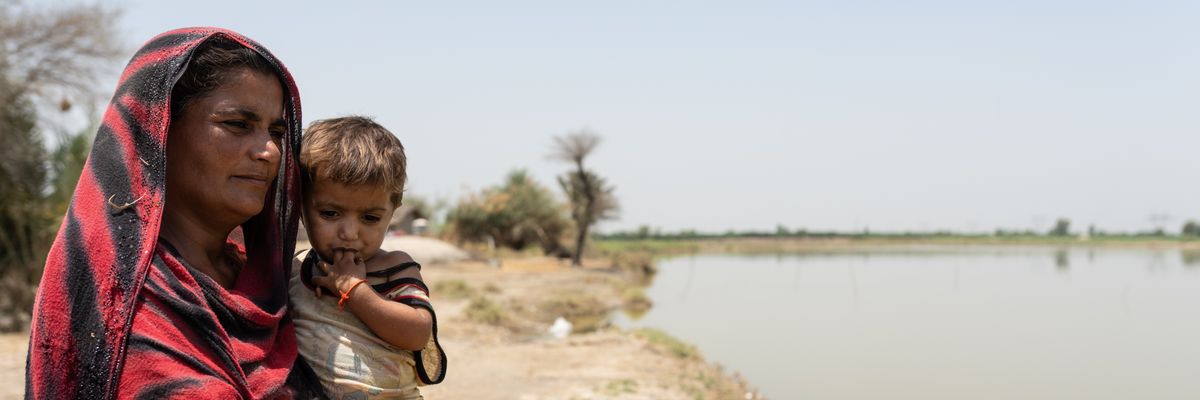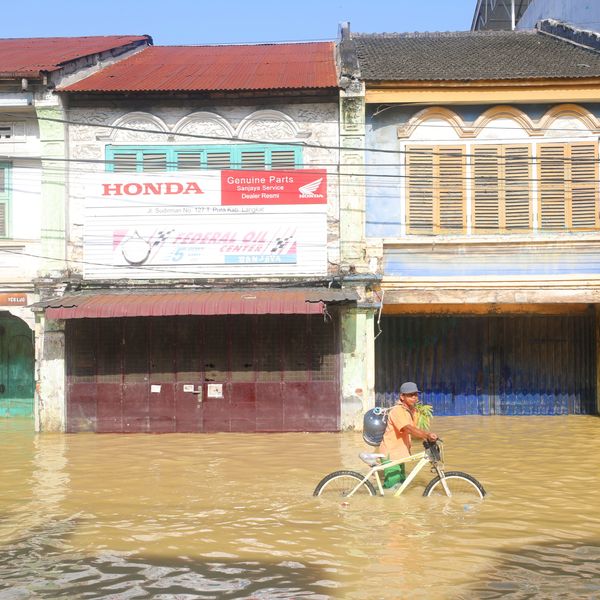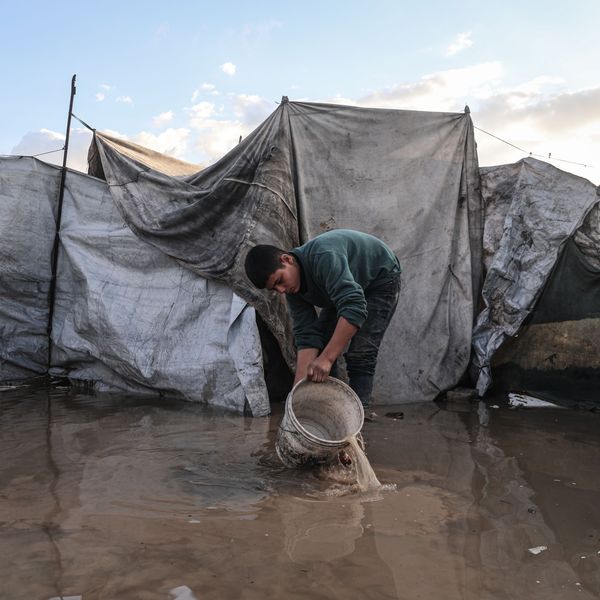
Benazir, 30, stands with her daughter, Oumara, 3, next to stagnant water that still remains more than six months after the devastating floods of 2022 in Sindh, Pakistan.
43 Million Children Forced From Homes Over Six Years Due to Climate Disasters
Children in countries such as South Sudan and Somalia were displaced by flooding, while young people in wealthy countries including the U.S. were forced to flee wildfires and other extreme events.
The U.N.'s children's welfare agency released a new report Friday making the case for prioritizing the protection of children from fossil fuel-driven climate disasters—with more than 43 million children across the globe internally displaced in a six-year period due to drought, flooding, wildfires, and other extreme events.
In the report Children Displaced in a Changing Climate, United Nations Children's Fund (UNICEF) details how 95% of child displacements in 44 countries from 2016-21 were due to flooding and storms, with 40.9 million children forced from their homes in countries including Guatemala, South Sudan, and Somalia.
"It is terrifying for any child when a ferocious wildfire, storm, or flood barrels into their community," said UNICEF executive director Catherine Russell. "For those who are forced to flee, the fear and impact can be especially devastating, with worry of whether they will return home, resume school, or be forced to move again. Moving may have saved their lives, but it's also very disruptive."
South Sudan and Somalia recorded the greatest number of child displacements from flooding, with 11.8% and 10.7% of their child populations forced to evacuate their homes due to the disasters.
But like much of the Global South, the climate threat facing Somalians is multi-pronged, and more than half of the global child displacements due to drought in the six-year period were also recorded in Somalia.
The report includes the story of a 10-year-old girl named Hibo, whose family was forced to leave their home in Guriel in search of food and water. They traveled for 10 days to reach a camp for internally displaced people.
"We arrived at this camp seven days ago, hoping things will be better," an 18-year-old mother named Ayesha, also living in the camp, told UNICEF. "My family has lost all our cattle and camels. They all died because we had no water to give them. We have nothing."
Children in countries that are facing numerous overlapping crises, including violent conflicts and persistent poverty, are at heightened risk of displacement, as they face "limited investment in risk mitigation and preparedness."
"For example, Haiti is high risk and is also dealing with conflict, violence, poverty, [and] earthquakes," reads the report, which provides the first global analysis of the child displacement crisis. "In Mozambique, poor communities are disproportionately affected with little capacity to recover from consecutive disasters."
"It is in these countries, where risk mitigation, adaptation, and preparedness—including embracing preemptive evacuations and other climate mobility options to save lives and minimize any disruption to children's access to critical services—is most urgent," reported UNICEF.
But the report suggests that people in wealthy countries should not think of climate-driven displacement of families and children as crisis that affects only the Global South.
Wildfires were the cause of 810,000 child displacements, with a third of those taking place in 2020 alone. The countries with the highest number of children driven from their homes by out-of-control blazes were the United States, Canada, and Israel.
Most displacements triggered by wildfires were preemptive evacuations coordinated by federal and state officials, but they carry risks for children's well-being just as the displacements of children in the Horn of Africa and other parts of the world do.
"As wildfires grow more intense, frequent, and widespread, many children who live through them are experiencing lasting psychological trauma such as anxiety, depression and post-traumatic stress disorder," reads the report. "Children may also develop sleep or attention problems or struggle in school. If not managed, their emotional trauma can affect their physical health, potentially leading to chronic health problems, mental illness, and substance use."
The Philippines, India, and China reported the highest numbers of child displacement in absolute numbers, while small nations including Dominica, Saint Maarten, and Northern Mariana Islands recorded the most child displacements relative to their child population.
Seventy-six percent of children in Dominica were displaced in the six-year period due to weather-related events such as Hurricane Maria, which damaged or destroyed 95% of the island's housing stock.
As the United Nations Climate Change Conference (COP28) draws near, UNICEF called on governments to:
- Protect children and young people from the impacts of climate change-exacerbated disasters and displacement by ensuring that child-critical services—including education, health, nutrition, social protection, and child protection services—are shock-responsive, portable and inclusive, including for those already uprooted from their homes;
- Prepare children and young people to live in a climate-changed world by improving their adaptive capacity and resilience, and enabling their participation in finding inclusive solutions; and
- Prioritize children and young people—including those already uprooted from their homes—in disaster and climate action and finance, humanitarian, and development policy, and investments to prepare for a future already happening.
"As the impacts of climate change escalate, so too will climate-driven movement," Russell said. "We have the tools and knowledge to respond to this escalating challenge for children, but we are acting far too slowly. We need to strengthen efforts to prepare communities, protect children at risk of displacement, and support those already uprooted."
An Urgent Message From Our Co-Founder
Dear Common Dreams reader, The U.S. is on a fast track to authoritarianism like nothing I've ever seen. Meanwhile, corporate news outlets are utterly capitulating to Trump, twisting their coverage to avoid drawing his ire while lining up to stuff cash in his pockets. That's why I believe that Common Dreams is doing the best and most consequential reporting that we've ever done. Our small but mighty team is a progressive reporting powerhouse, covering the news every day that the corporate media never will. Our mission has always been simple: To inform. To inspire. And to ignite change for the common good. Now here's the key piece that I want all our readers to understand: None of this would be possible without your financial support. That's not just some fundraising cliche. It's the absolute and literal truth. We don't accept corporate advertising and never will. We don't have a paywall because we don't think people should be blocked from critical news based on their ability to pay. Everything we do is funded by the donations of readers like you. Will you donate now to help power the nonprofit, independent reporting of Common Dreams? Thank you for being a vital member of our community. Together, we can keep independent journalism alive when it’s needed most. - Craig Brown, Co-founder |
The U.N.'s children's welfare agency released a new report Friday making the case for prioritizing the protection of children from fossil fuel-driven climate disasters—with more than 43 million children across the globe internally displaced in a six-year period due to drought, flooding, wildfires, and other extreme events.
In the report Children Displaced in a Changing Climate, United Nations Children's Fund (UNICEF) details how 95% of child displacements in 44 countries from 2016-21 were due to flooding and storms, with 40.9 million children forced from their homes in countries including Guatemala, South Sudan, and Somalia.
"It is terrifying for any child when a ferocious wildfire, storm, or flood barrels into their community," said UNICEF executive director Catherine Russell. "For those who are forced to flee, the fear and impact can be especially devastating, with worry of whether they will return home, resume school, or be forced to move again. Moving may have saved their lives, but it's also very disruptive."
South Sudan and Somalia recorded the greatest number of child displacements from flooding, with 11.8% and 10.7% of their child populations forced to evacuate their homes due to the disasters.
But like much of the Global South, the climate threat facing Somalians is multi-pronged, and more than half of the global child displacements due to drought in the six-year period were also recorded in Somalia.
The report includes the story of a 10-year-old girl named Hibo, whose family was forced to leave their home in Guriel in search of food and water. They traveled for 10 days to reach a camp for internally displaced people.
"We arrived at this camp seven days ago, hoping things will be better," an 18-year-old mother named Ayesha, also living in the camp, told UNICEF. "My family has lost all our cattle and camels. They all died because we had no water to give them. We have nothing."
Children in countries that are facing numerous overlapping crises, including violent conflicts and persistent poverty, are at heightened risk of displacement, as they face "limited investment in risk mitigation and preparedness."
"For example, Haiti is high risk and is also dealing with conflict, violence, poverty, [and] earthquakes," reads the report, which provides the first global analysis of the child displacement crisis. "In Mozambique, poor communities are disproportionately affected with little capacity to recover from consecutive disasters."
"It is in these countries, where risk mitigation, adaptation, and preparedness—including embracing preemptive evacuations and other climate mobility options to save lives and minimize any disruption to children's access to critical services—is most urgent," reported UNICEF.
But the report suggests that people in wealthy countries should not think of climate-driven displacement of families and children as crisis that affects only the Global South.
Wildfires were the cause of 810,000 child displacements, with a third of those taking place in 2020 alone. The countries with the highest number of children driven from their homes by out-of-control blazes were the United States, Canada, and Israel.
Most displacements triggered by wildfires were preemptive evacuations coordinated by federal and state officials, but they carry risks for children's well-being just as the displacements of children in the Horn of Africa and other parts of the world do.
"As wildfires grow more intense, frequent, and widespread, many children who live through them are experiencing lasting psychological trauma such as anxiety, depression and post-traumatic stress disorder," reads the report. "Children may also develop sleep or attention problems or struggle in school. If not managed, their emotional trauma can affect their physical health, potentially leading to chronic health problems, mental illness, and substance use."
The Philippines, India, and China reported the highest numbers of child displacement in absolute numbers, while small nations including Dominica, Saint Maarten, and Northern Mariana Islands recorded the most child displacements relative to their child population.
Seventy-six percent of children in Dominica were displaced in the six-year period due to weather-related events such as Hurricane Maria, which damaged or destroyed 95% of the island's housing stock.
As the United Nations Climate Change Conference (COP28) draws near, UNICEF called on governments to:
- Protect children and young people from the impacts of climate change-exacerbated disasters and displacement by ensuring that child-critical services—including education, health, nutrition, social protection, and child protection services—are shock-responsive, portable and inclusive, including for those already uprooted from their homes;
- Prepare children and young people to live in a climate-changed world by improving their adaptive capacity and resilience, and enabling their participation in finding inclusive solutions; and
- Prioritize children and young people—including those already uprooted from their homes—in disaster and climate action and finance, humanitarian, and development policy, and investments to prepare for a future already happening.
"As the impacts of climate change escalate, so too will climate-driven movement," Russell said. "We have the tools and knowledge to respond to this escalating challenge for children, but we are acting far too slowly. We need to strengthen efforts to prepare communities, protect children at risk of displacement, and support those already uprooted."
- Pakistan Declares National Emergency as Climate-Intensified Floods Devastate 33 Million ›
- UN Expert Demands Full Legal Protection for Climate Refugees ›
- Record 76 Million Internally Displaced in 2023, Largely Due to Violence | Common Dreams ›
- Opinion | Stranded by the Floods in South Sudan | Common Dreams ›
The U.N.'s children's welfare agency released a new report Friday making the case for prioritizing the protection of children from fossil fuel-driven climate disasters—with more than 43 million children across the globe internally displaced in a six-year period due to drought, flooding, wildfires, and other extreme events.
In the report Children Displaced in a Changing Climate, United Nations Children's Fund (UNICEF) details how 95% of child displacements in 44 countries from 2016-21 were due to flooding and storms, with 40.9 million children forced from their homes in countries including Guatemala, South Sudan, and Somalia.
"It is terrifying for any child when a ferocious wildfire, storm, or flood barrels into their community," said UNICEF executive director Catherine Russell. "For those who are forced to flee, the fear and impact can be especially devastating, with worry of whether they will return home, resume school, or be forced to move again. Moving may have saved their lives, but it's also very disruptive."
South Sudan and Somalia recorded the greatest number of child displacements from flooding, with 11.8% and 10.7% of their child populations forced to evacuate their homes due to the disasters.
But like much of the Global South, the climate threat facing Somalians is multi-pronged, and more than half of the global child displacements due to drought in the six-year period were also recorded in Somalia.
The report includes the story of a 10-year-old girl named Hibo, whose family was forced to leave their home in Guriel in search of food and water. They traveled for 10 days to reach a camp for internally displaced people.
"We arrived at this camp seven days ago, hoping things will be better," an 18-year-old mother named Ayesha, also living in the camp, told UNICEF. "My family has lost all our cattle and camels. They all died because we had no water to give them. We have nothing."
Children in countries that are facing numerous overlapping crises, including violent conflicts and persistent poverty, are at heightened risk of displacement, as they face "limited investment in risk mitigation and preparedness."
"For example, Haiti is high risk and is also dealing with conflict, violence, poverty, [and] earthquakes," reads the report, which provides the first global analysis of the child displacement crisis. "In Mozambique, poor communities are disproportionately affected with little capacity to recover from consecutive disasters."
"It is in these countries, where risk mitigation, adaptation, and preparedness—including embracing preemptive evacuations and other climate mobility options to save lives and minimize any disruption to children's access to critical services—is most urgent," reported UNICEF.
But the report suggests that people in wealthy countries should not think of climate-driven displacement of families and children as crisis that affects only the Global South.
Wildfires were the cause of 810,000 child displacements, with a third of those taking place in 2020 alone. The countries with the highest number of children driven from their homes by out-of-control blazes were the United States, Canada, and Israel.
Most displacements triggered by wildfires were preemptive evacuations coordinated by federal and state officials, but they carry risks for children's well-being just as the displacements of children in the Horn of Africa and other parts of the world do.
"As wildfires grow more intense, frequent, and widespread, many children who live through them are experiencing lasting psychological trauma such as anxiety, depression and post-traumatic stress disorder," reads the report. "Children may also develop sleep or attention problems or struggle in school. If not managed, their emotional trauma can affect their physical health, potentially leading to chronic health problems, mental illness, and substance use."
The Philippines, India, and China reported the highest numbers of child displacement in absolute numbers, while small nations including Dominica, Saint Maarten, and Northern Mariana Islands recorded the most child displacements relative to their child population.
Seventy-six percent of children in Dominica were displaced in the six-year period due to weather-related events such as Hurricane Maria, which damaged or destroyed 95% of the island's housing stock.
As the United Nations Climate Change Conference (COP28) draws near, UNICEF called on governments to:
- Protect children and young people from the impacts of climate change-exacerbated disasters and displacement by ensuring that child-critical services—including education, health, nutrition, social protection, and child protection services—are shock-responsive, portable and inclusive, including for those already uprooted from their homes;
- Prepare children and young people to live in a climate-changed world by improving their adaptive capacity and resilience, and enabling their participation in finding inclusive solutions; and
- Prioritize children and young people—including those already uprooted from their homes—in disaster and climate action and finance, humanitarian, and development policy, and investments to prepare for a future already happening.
"As the impacts of climate change escalate, so too will climate-driven movement," Russell said. "We have the tools and knowledge to respond to this escalating challenge for children, but we are acting far too slowly. We need to strengthen efforts to prepare communities, protect children at risk of displacement, and support those already uprooted."
- Pakistan Declares National Emergency as Climate-Intensified Floods Devastate 33 Million ›
- UN Expert Demands Full Legal Protection for Climate Refugees ›
- Record 76 Million Internally Displaced in 2023, Largely Due to Violence | Common Dreams ›
- Opinion | Stranded by the Floods in South Sudan | Common Dreams ›

